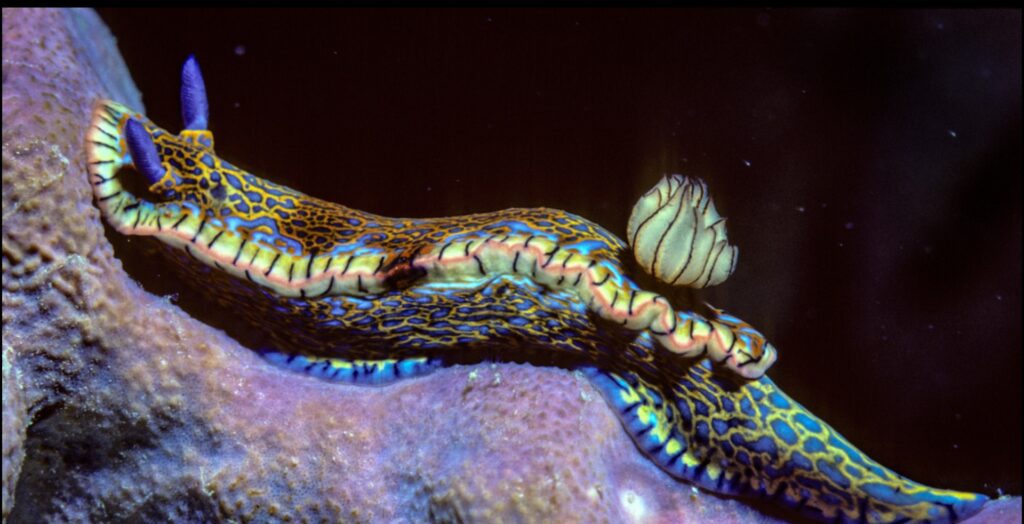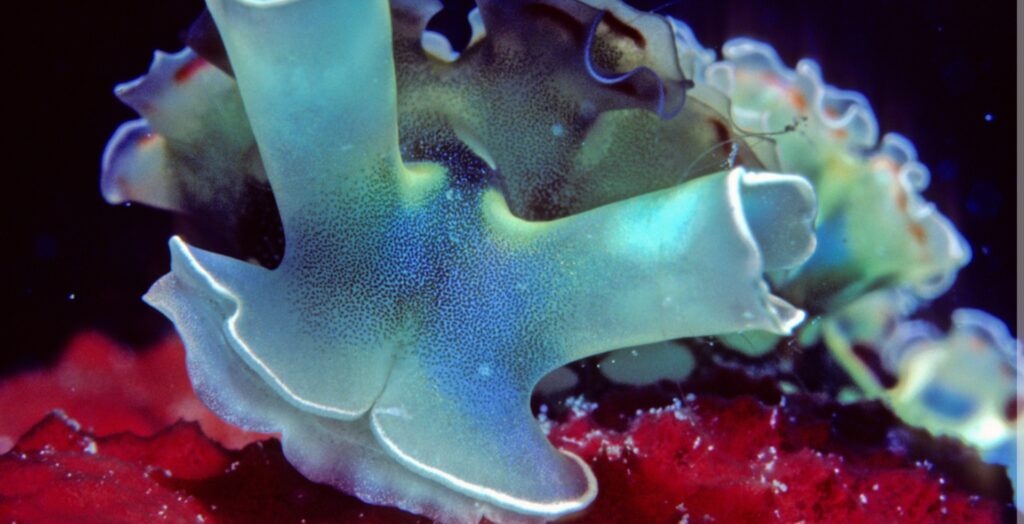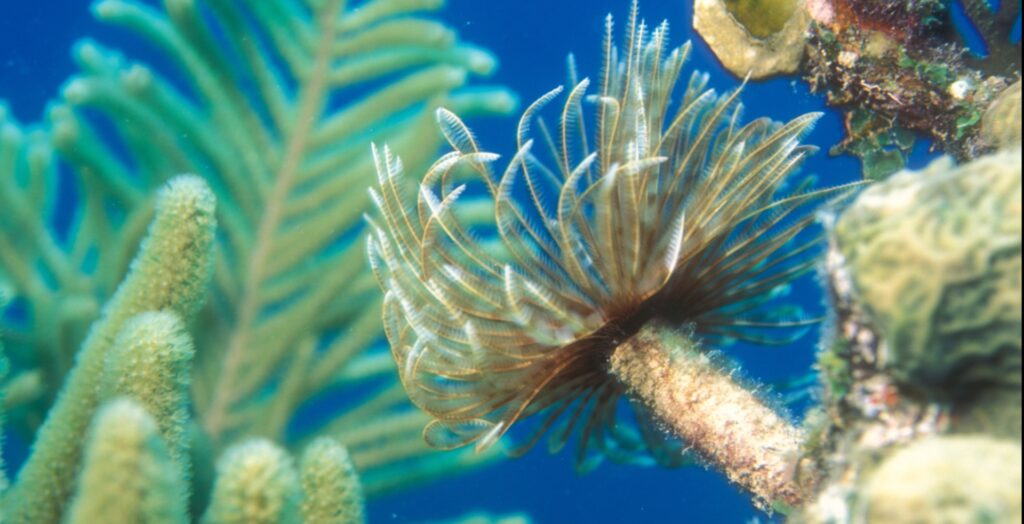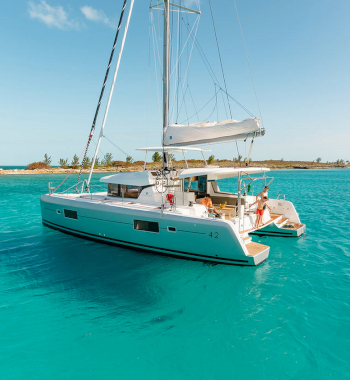The BVI’s Wondrous & Strange Marine Invertebrates
by Jim Scheiner
Up close and personal with the BVI’s beautiful and wondrous marine invertebrates

I must look ridiculous, stretched out on the sand at 60 feet. I haven’t moved a fin for over half an hour, my facemask is inches from a non-descript piece of dead coral. I’ve just shot an entire roll of film and to top it off, I’m ten minutes into decompression. And for what? Not a rare species of anglerfish, not mating woebegone sharks, not even a pretty cardinal fish. But a tiny, ordinary sea slug! A shell-less snail, a two-inch long blob of boneless flesh, a nudibranch. I know it doesn’t make a lot of sense, but you see, I have this thing for sea slugs. In fact, I have a passion for all the spineless wonders of the sea.
It’s an acquired taste. Fish normally get all the glory. New divers and snorkelers are invariably drawn to those dazzlingly colored, active, backboned stars of the sea. Fish look you in the eye, eat, get eaten, live normal lives. When all is said and done, they’re not too different from you and I. But the invertebrate creatures – those animals without back bones, from lowly sponges to sea urchins and octopus, are so alien that many people, of they stop to think about them at all, wouldn’t even know if they’re animal, vegetable, mineral, or even alive. Yet to know them is to love them. Their survival strategies are so unique, so imaginative, that even a rudimentary understanding draws them close to our hearts. And besides, unlike cowardly fish who usually flee, most invertebrate creatures are small and immobile so they are easy to observe and study.
Anchored to the bottom, sponges are often ignored as inanimate objects not worthy of closer inspection, appreciated only for their bright colors. They don’t react when touched, not even an involuntary shudder or flinch. But drop a handful of fine sand above a loggerhead sponge and its vitality will amaze you. The sand will boil up as if caught in a strong current, which it is. Drawing in large volumes of seawater through the innumerable tiny pores that line its flanks, sponges sift out prey as small as bacteria and then pump a constant flow of filtered sea water back through their large “excurrent” holes. They’re the vacuum cleaners of the sea. Lots of creatures live on or in sponges, hiding from predators or taking advantage of the micro-environment created by the sponge’s feeding process. Some sponges grow to huge proportions and live so long that they are thought of as permanent structures of the reef.

Challenging the sponges for supremacy in the living tapestry of the reef are the corals. Invisible in our sense of time, there is an epic struggle between the corals and sponges for a stable surface to grow on. This timeless war is fought with chemical and biological weapons, as well as physical attacks. The sponges use acids to bore away the limestone skeleton of the corals and the corals fight back with stinging tentacles. These slow-motion victories and defeats are marked by the gradual ebb and flow of the dominance of one species over another.
Colorful Corals
Corals blur the classic distinction of “animal, vegetable, or mineral” by being all three. The individual match-head sized coral polyp is a living animal, stalking the plankton-rich currents that bathe its immobile structure (with tiny barb-laden tentacles and a voracious mouth.) Living within the coral’s flesh are tiny zooxanthellae, microscopic plant cells that carry on photosynthesis, converting sunlight to food. If the coral is exposed to enough sunlight, the zooxanthellae can actually make enough food to feed its host too. Now here’s where it gets interesting. The coral animal builds a calcium carbonate (limestone) skeleton in which it lives, but the carbon dioxide it releases as a waste is converted by seawater into acid which tends to dissolve this skeleton. However, the zooxanthallae utilize the carbon dioxide to make food. In this astonishing partnership, the coral and the zooxanthallae, as a unit, both feed on plankton and make their own food from sunlight as well as take recycled wastes and convert them into growth. It took scientists decades to figure this all out. This mutually beneficial relationship allows corals to thrive and build the huge reef systems that provide shelter and for so many other creatures.
Shrimps, Lobsters and Crabs
And there are a lot of creatures. Rivaling a tropical rainforest for diversity, a coral reef hosts an abundance of beautiful and bizarre creatures. Shrimps, lobsters and crabs are everywhere. Like their terrestrial relatives, the insects, these hard skinned, many legged creatures are lurking in every crack and crevice. Lobsters are easily spotted with their long antenna protruding out from a protective lair. Hermit crabs are more forthright, crawling out in the open in their mobile fortresses, retracting completely when threatened. Their time of maximum vulnerability comes when they outgrow their borrowed seashell home and must move to a larger one. After carefully selecting a shell of just the right size, the hermit crab has to scramble naked from one shell to the next, exposing its tender abdomen in the process.
Two other crustaceans work at cross-purposes. Parasitic isopods attach themselves to the living tissues of fish and feet of the unwitting host’s vital fluids. Perhaps as a compensation, certain species of tiny shrimp act as cleaners. Advertising their services with a florid wave of their long antenna they climb all over interested fish, plucking off and eating tiny parasites with their minute claws.

Rarely are worms described as beautiful. But underwater, even worms are fascinating. The various feather duster and Christmas tree worms don’t look worm-like at all. They hide their squirmy bodies in a tube that goes back into the coral and that is left protruding are exquisite, delicate, feather-like gills. These tasty treats are protected by the worm’s lightening fast reflexes. Approach too closely and the gills are instantly retracted. In contrast, the eight-inch long fire worm crawls about the reef without any obvious protection. But disturb it and its entire body erupts with tufts of white bristles. These detach and easily penetrate the skin. The resulting pain and long lasting irritation made the fire worm one of the few true touch-me-nots on the reef.
The Amazing Octopus
Perhaps the most amazing of all the invertebrate creatures is the octopus. Anyone who has ever witnessed this “alien intelligence” will agree that they are strong-willed clever creatures. They possess the most highly evolved eye of all invertebrates and can see about as well as you and I can. They are curious, willful and seem to have strong personalities, occasionally playing hide and seek with divers. Though they are related to clams (both are mollusks), which are not known for their intellectual aptitude, octopus are about as intelligent and active as a pet poodle. Laboratory tests have shown them (octopus – not poodles) to be great problem solvers, quickly learning how to remove shrimp from a glass globe.
But, it’s outside of the laboratory where octopus show their true colors, literally. Many divers have been stopped in their tracks, dumbfounded, the first time they saw an octopus go through its color changes. I don’t mean slow gentle transitions like a chameleon, but quick pulses, rapid waves of color that literally flow over the body and then down the arms. Brown becomes white, stripes change to patches, turquoise alternates with emerald. Shifts in hue as subtle as flickering candlelight play on top of dramatic rock-concert style color changes. Even their normally velvety smooth skin gets involved, going from smooth to wrinkled to knobby, barely keeping pace with the colors. An octopus wears its emotions on its sleeve and a really excited octopus can cycle through its colors so fast that it’s hard to believe you’re not imagining it. And that’s not all; their boneless bodies can squeeze through the tiniest holes. They can fly through the water by jet propelling water out their siphon and they can squirt a thick cloud of black ink as a diversionary tactic when fleeing a particularly persistent predator. Divers often find octopuses by locating the litter of shells that line the entrance of their dens. After mating, the female retreats to their den and lays scores of eggs. She tends them continually until they hatch, whereupon she expires, succumbing to starvation and exhaustion.
The Nudibranch and the Sea Slugs
But what about the aforementioned sea slugs? What makes them so special? First of all, the name “sea slug” is a grave injustice to the fantastic colors and outlandish body shapes of these creatures. Some are brilliant yellow, while others are painted with an outrageous pattern of stripes and dots that clash with the equally garish tufts on the animal’s back. Most are less than two inches long and can sit comfortably on the tip of your finger. With an estimated 3000 species worldwide, the lowly nudibranch (a singular group of sea slugs) is an unexpected outpouring of nature’s creativity. And since form does indeed follow function, nudibranches also demonstrate some of biology’s most ingenious adaptations.
For starters, they’re hermaphrodites, meaning that they can mate with and mutually realize any adult of their species that they happen upon. As peculiar as that might be, it’s not that unusual in the sub-dea realm. What really sets these little slugs apart is their expertise as “biological burglars.” Many nudibranches feed on anemones and hydroids. Normally the stinging cells of these animals protect them from being eaten. However, not only is the foraging nudibranch undeterred by such defenses, but after eating its prey, it manages to separate the stinging cells from the rest of its dinner and store them undischarged in the tips of the projections that line its back. When a fish comes along and decides to eat the “defenseless “ Slug, it ends up with a mouthful of stinging cells and spits the creature out. The nudibranch uses the defense of its prey for its own defense. Others steal and incorporate pigments from their food, a sponge perhaps, and change color so as to be completely camouflaged as they slowly much away on their prey.
The common Caribbean lettuce sea slug is a thief of a different sort. As a vegetarian it uses a specialized tongue to pierce the cell walls of algae and suck out the contents, most of which are digested. It manages to save the algae’s chloroplast and store them in the ruffles along its back where they continue to carry on the uniquely plant activitiy of photosynthesis. While the reef building corals and even giant clams also have symbiotic algae with their tissues (their zooxanthellae) this solar powered sea slug uniquely does it by theft.
Shapeless blobs, alien intelligences, crafty thieves, these are just some invertebrate creatures inhabiting the undersea realm. And though some, like the sponges are considered to be the most primitive of all multicellular animals, who’s to say that a creature that is so successful that it hasn’t had to change for hundreds of millions of years is lower or more primitive than the transient Johnny-come-latelies whose pinnacle we represent.
Read more about the BVI’s underwater realm at:
Or go to:






